Plastics in the environment
Research and impact 2 March 2020
Dr Ian Kane told us about the work that academics and students at the Department of Earth and Environmental Sciences at Manchester are doing to investigate the impact of microplastics on oceanic ecosystems. The outcome of these investigations will be used to inform future mitigation measures against plastic pollution.
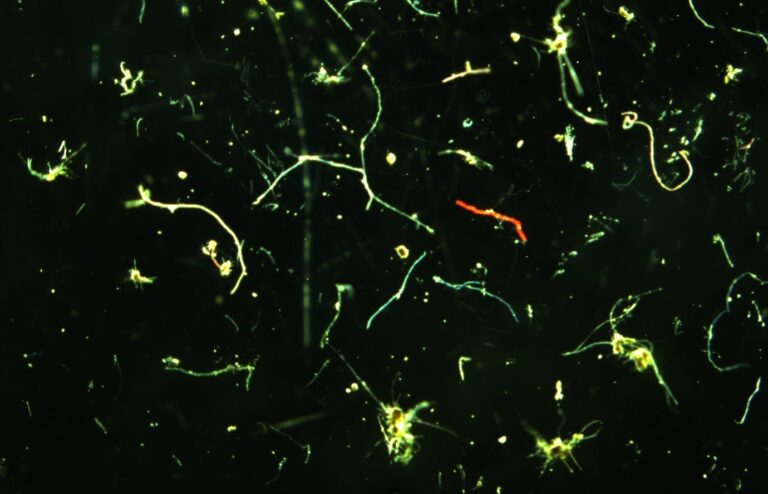
Plastics are versatile, durable, and ubiquitous in modern society. Unfortunately, the properties that make plastic so desirable as a material also mean that they are persistent in the natural environment. Much plastic waste is not disposed of responsibly, from the individual consumer to the societal level. As a consequence, plastic is common in all of Earth’s environments. It is found on the highest mountains and in the deepest ocean trenches, and everywhere else in between.
Microplastics in particular have caught the public imagination as a particularly insidious form of anthropogenic pollutant: tiny fragments and fibres may be invisible to the naked eye, but they can be ingested with the food and water we consume, and they can be absorbed into the flesh of organisms. But microplastics may just be the tip of the iceberg, with nanoplastics (even smaller particles) now known to infiltrate groundwater systems. The big concern is that while ‘fresh’ microplastics may be relatively inert, through time they can accumulate and adsorb toxins, and develop biofilms on their surfaces. We do not yet understand how these plastics interact with sensitive ecosystems, or how plastics will degrade and breakdown through time, especially on the deep, dark and poorly-oxygenated ocean floors.
Plastics enter river systems from a wide range of sources, including waste-water treatment plants, run-off from roads and other urban environments, and from various industrial sources. Researchers in Manchester have documented how microplastics, including microbeads from cosmetics and industrial sources, fragments derived from breakdown of larger objects, and fibres from textiles and other plastics, are trapped in the beds of rivers and their floodplains, but may be ‘flushed’ out during flood events. So what happens to that plastic? Eventually it makes its way to the coast and is washed into the open sea. Depending on its density those plastics may float, or sink.
In the Department of Earth and Environmental Sciences at the University of Manchester, we have been focusing on understanding the problem of microplastics in the world’s oceans. We’ve all heard of the five great ocean garbage patches, and while these are alarming they are relatively small compared with the amount of plastic on the seafloor. In collaboration with scientists at the National Oceanography Centre, we have shown that microplastics are not distributed randomly on the seafloor, but are focused in particular environments. While it has been documented previously that plastics occurs on the seafloor, the distribution and the processes that control plastic distribution have never been linked.
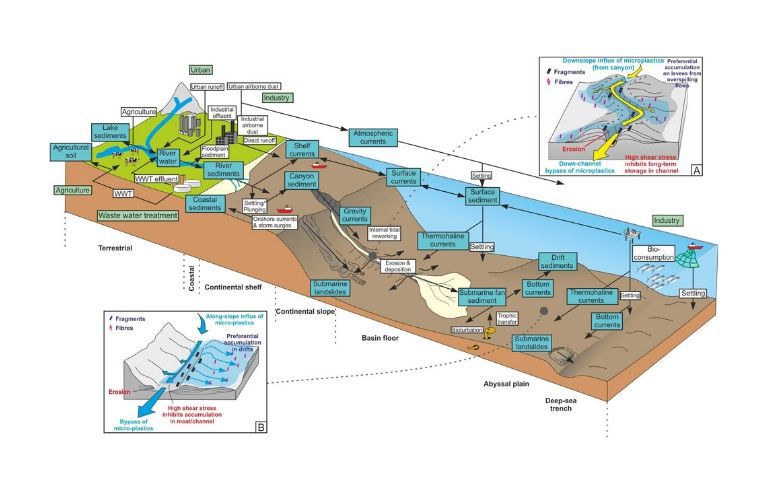 The ‘microplastics cycle’, illustrating how microplastics enter the natural environment and are transported and redistributed on the deep sea floor (from a paper published by Ian Kane and Michael Clare, in Frontiers, 2019).
The ‘microplastics cycle’, illustrating how microplastics enter the natural environment and are transported and redistributed on the deep sea floor (from a paper published by Ian Kane and Michael Clare, in Frontiers, 2019).
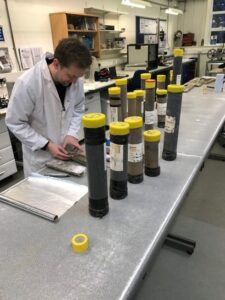
Collecting samples from seafloor cores at the National Oceanography Centre, with Dr Michael Clare.
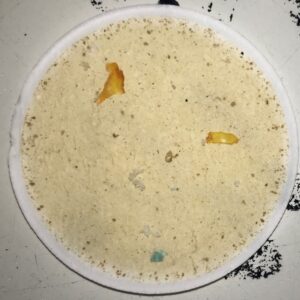
Filter paper with micro- and macroplastic residue from a seafloor sample.
It has been suggested that plastics are moved from the coast to much deeper water by turbidity currents – dense mixtures of sand, mud and water, which cascade down the continental shelves into the abyss. In addition some plastic settles from the sea surface through time, due to densification by mineral and biofilm accumulation on surfaces.
Submarine canyons, which indent Earth’s continental shelves, are pathways for these turbidity currents. They are fed by material delivered to the coast by rivers, including anthropogenic waste. Turbidity currents travel down these canyons and deposit sediment in the largest sediment accumulations on Earth, submarine fans. That isn’t the end of the story though. The oceans are not simply stagnant bodies of water instead, like the atmosphere, they are subject to powerful currents, here driven by differences in heat and salinity. These ‘thermohaline’ currents can move at several metres per second and are capable of redistributing the sediment deposited in submarine fans. Thermohaline currents build dune-like deposits known as ‘drifts’, which can be hundreds of metres high and kilometres across.
Using sediment seafloor samples from the Tyhrennian Sea, between Sardinia and Italy, we have shown that microplastics number up to 1.9 million pieces per square metre, the highest levels ever recorded; these high numbers occur in seafloor drift deposits, demonstrating the importance of thermohaline currents in redistributing anthropogenic pollutants on the seafloor.
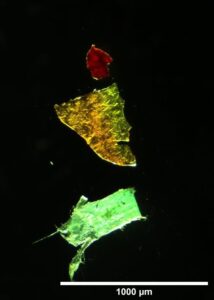
Microplastic fragments collected from around 1 km water depth in the Tyhrennian Sea.
Perhaps the most unfortunate aspect of the mobility of microplastics in the environment is that they are delivered to the same places as nutrients and oxygenated water which form the basis for ecosystems on the seafloor. In turn, these ecosystems form the building blocks of the trophic web, or food chain, of which we sit at the top.
Our future research aims to identify the sources and pathways that plastics take into natural systems, and to identify the contexts in which they are ultimately sequestered, and the ecosystems they affect. Much more work needs to be done to systematically sample different seafloor environments to understand the residence of time of plastic on the seafloor and both how and where it is ultimately buried. Ultimately this research aims to understand the nature of plastic contamination so we can develop strategies for mitigation, and techniques to evaluate the impact of mitigation attempts.
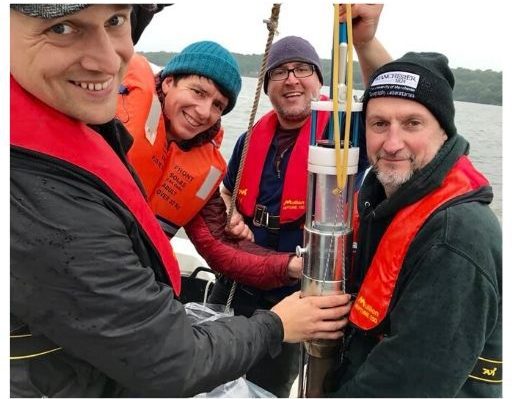
Dr Ian Kane (second left) and colleagues holding a sample collected from the Liverpool Bay seafloor.

Early morning start to collect samples to analyse for microplastic contamination, near Wallasey, on the Wirral. MEarthSci student Edward Keavney bags the sample while MPEC student Ginevra Oertel records the GPS location and sample notes.
anthropogenic pollutantecosystemsmicroplasticsmitigationnanoplasticsocean garbagepathwaysplastic distributionseafloorsubmarine fansthermohalineturbidity currentsTyhrennian sea

Leave a Reply